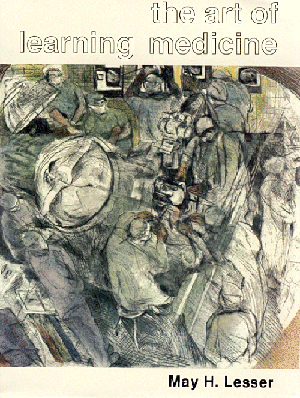May H. Lesser, Appleton-Century-Crofts, New York City, 1974
From the cover of The Art of Learning Medicine; also figure 264, page 295
Here is a drypoint engraving printed in color of Dr. Paul Crandall's operation to insert electrodes into the brain. A mathematician had frontal lobe seizures, and the surgeons were implanting electrodes to attach to the EEG machine to locate the trouble in the brain. The print shows the professor on both sides, as the engraving is done progressively; that is, I began at 10:00 A.M. when he first began on the patient's right side and then he continued to his left side. I included Eddie, who made measurements on the x-rays with a plastic ruler, and Jim, with his arms folded in the upper left of the print, who recorded EEG tracings from the depth electrodes during the following six weeks. The professor's hand was done twice, once feeling the tip of the drill at the patient's skull and then two hands on the drill. All around Dr. Crandall were the onlookers; other surgeons and residents, medical students, and nursing staff. It was interesting to note that the ones not actually involved have a much lessened intensity in their postures, down to the circulation nurse who even faces the other way. I made the color soft, because I sensed the delicacy of the procedure and also the strain of the hours (I left at 3:30 P.M.). I appreciated the professor's talent and was impressed by the total orchestration of his staff.
Last Reviewed: May 11, 2012



